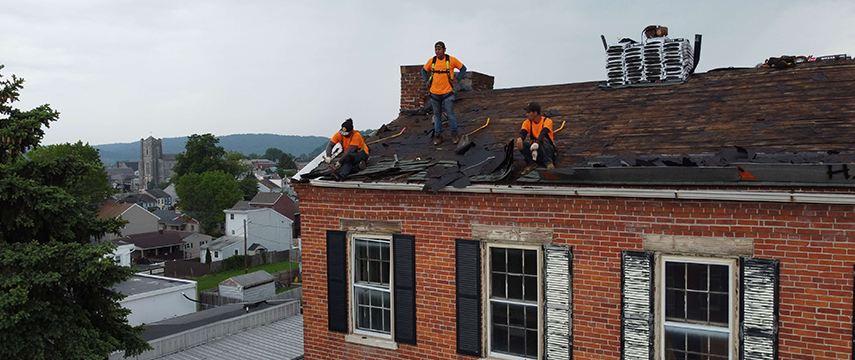A house is only as good as its roof. In central Pennsylvania, every season brings something different, from humid summers to snowy winters. Your roof needs to be able to handle all of it. Today we’ll cover the types of roof damage repairs every Pennsylvania homeowner should know.
12 Most Common Types of Roof Damage Repairs
From intense weather to general wear and tear, your roof can handle a lot. But every house has its breaking point. A strong, healthy roof is critical, especially as you enter storm or snow season. Here are the main dangers to watch out for throughout the year and how to spot damage from each one.
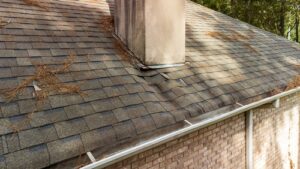
1. Water Damage
A single rainstorm probably won’t cause major damage, but over time, excessive moisture can have an impact on your roof. Lots of elements can cause water damage—broken flashing, cracked shingles, clogged gutters, rotting wood, and more. Leaks in your roof typically start small but can quickly escalate into a major issue. Moisture can also lead to mold, mildew, and rot.
To prevent water damage, find the source of the dripping as soon as you can and properly maintain your roof to keep it watertight. If you need leak repairs, our team will find the source of the water, assess the damage, and either repair or replace the damaged shingles, wood, and flashing.
Spot water damage by:
- Cracked shingles
- Sagging ceiling
- Dripping water
- Water stains
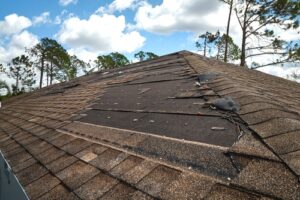
2. Wind Damage
Wind may not seem like a big deal at first, but high winds during a storm can rip off shingles and scatter debris across your property. This weakens the structural integrity of your roof and exposes it to the elements, potentially causing leaks.
Wind and storm damage repair can be as simple as replacing shingles, patching leaks, and removing debris. However, hurricane-force winds can do serious damage that may require a more extensive fix. While you can’t prevent wind damage completely, you can choose materials with a higher wind rating.
Spot wind damage by:
- Loose or missing shingles
- Loose nails
- Compromised roof interior
- Debris on the roof
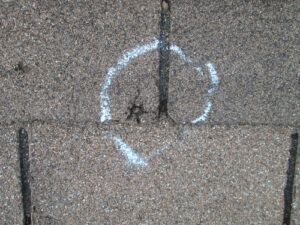
3. Hail Damage
A hailstorm isn’t fun for you or your roof. However, the intensity of the storm, size of the hail, wind speed, and wind direction all make a difference in the amount of damage. Hail can pierce the granules in your shingles, leaving them exposed to UV rays and moisture. If unaddressed, this can lead to major problems like leaks.
Since you can’t control the weather, hail damage is hard to avoid completely. However, some roof materials are more prone to dents and damage, like aluminum. Knowing the strength of your roof will help you to handle hail damage if it comes. Repairs are usually minor, but if the storm is serious enough, a full replacement may be necessary.
Spot hail damage by:
- Cracked or dented shingles
- Granule loss (check your gutters!)
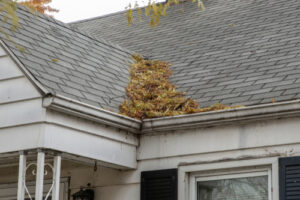
4. Debris Damage
Another type of roof damage repair comes from debris. A simple overhanging tree is more dangerous than you thought. High winds and heavy storms can often cause damage to your roof. Even the smallest debris like leaves and pine needles can trap moisture, clog gutters, and lead to mold and rot.
When this happens, storm damage repairs involve removing and replacing the affected roofing materials. The more serious the debris damage, the larger the repairs. The best way to avoid debris is to trim trees back from your roof. Always check your roof after a storm and clear whatever you find if you are able. Lastly, maintain your gutters and keep them clean.
Spot debris damage by:
- Debris on the roof
- Clogged gutters
- Rotted wood
- Mold and mildew
- Punctured shingles
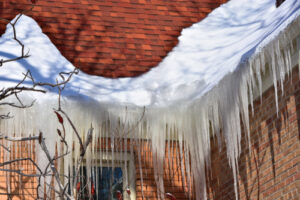
5. Snow and Ice Damage
Winters in Central PA are a force to be reckoned with. When piles of snow build up on your roof, the weight can cause it to buckle. It can also form an ice dam. This is when snow melts and then refreezes at the edge of your roof, creating a dam that blocks water from draining. Eventually, moisture gets under your shingles and damages your ceiling.
No one wants to deal with leak repairs. To help avoid snow and ice damage, get your roof inspected before a snow storm. It’s also good practice to clear your gutters and downspouts at the beginning of winter. After a storm, safely remove snow from your roof with a roof rake. This helps relieve the pressure of the heavy snow on top of your home.
Spot snow and ice damage by:
- Leaks
- Split or cracked shingles
- Clogged gutters
- Excessive icicles
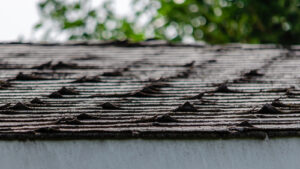
6. Heat Damage
Imagine laying outside in the middle of summer, just soaking up the sun. That’s what your roof does, all day, every day. Unlike us, our roof can’t hide in the shade or enjoy a break in the air conditioning. Your house is directly exposed to harsh UV rays, which can make your roof get too hot and damage the materials.
To avoid this, ventilation on roofs is key. Without it, the decking heats up from below and the roof absorbs heat from above. When this happens, shingles can bubble up and form blisters. If your roof has missing granules, UV rays can warp the shingles and cause a leak. Heat damage repairs involve replacing the affected materials and installing fans or vents to improve ventilation.
Spot heat damage by:
- Curling shingles
- Faded or rusted roof
- Cracked shingles
- Heat blisters
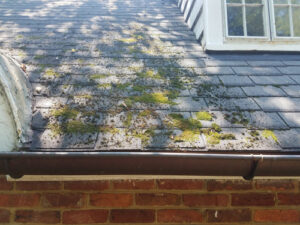
7. Fungus Damage
Mold, mildew, moss, and roof rot don’t just look bad. Fungus build-up can cause health issues and damage to the structure of your roof. Humidity and moisture are the main causes of fungus growth, along with bad ventilation. Over time fungus can get under your shingles and eat away at the roof decking, damaging materials and causing leaks.
If you notice mold and lichen, you can start by cleaning your roof. If the fungus continues to come back or begins to spread wildly, call a professional to replace the materials. Avoid the problem getting out of hand by frequently checking your roof for signs of fungus and moisture, cleaning your gutters, and ensuring proper ventilation on the roof.
Spot fungus damage by:
- Green or black patches of moss, mold, or mildew
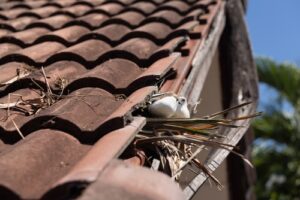
8. Pest Damage
Insects, rodents, and birds can do a lot of harm to your house. They can pose health issues and cause structural concerns. Plus they’re just a nuisance! When pests chew through wood, it can lead to expensive (and invasive) repairs. This can range from replacing shingles and patching leaks to fully redoing your roof decking.
The most common pests to watch out for are:
- Ants
- Termites
- Bees
- Rats
- Mice
- Squirrels
- Bats
- Birds
To keep pests out of your house and off your roof, keep foliage trimmed away from your home. Regularly practicing roof maintenance will help you spot easy points of entry, and if needed, you can work with an exterminator or animal control specialist to get rid of unwanted pests.
Spot pest damage by:
- Droppings
- Chewing or scratch marks
- Gaps in shingles
- Animal sounds (scratching, chirping)
- Nests
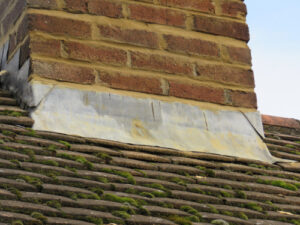
9. Flashing Damage
Flashing is the thin strips of metal attached at the seams of your roof where leaks are more likely to occur. It is typically installed around skylights, chimneys, and where the roof pitches connect. It effectively keeps water out of these vulnerable areas.
After bad weather, always visually check your flashing for immediate signs of damage. If you need a second pair of eyes, contact a professional to get it inspected. If damaged flashing sits for too long without getting fixed, it can lead to serious leaks, massive water damage, and even damage to the chimney itself. In most cases, flashing repair is simple and involves replacing the metal and surrounding shingles.
Spot flashing damage by:
- Smalls holes
- Rust or corrosion
- Cracks and dents
- Missing pieces
- Leaks near chimney
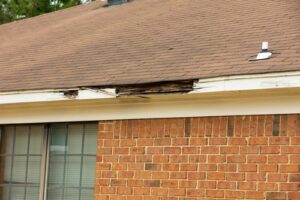
10. Structural Damage
This damage occurs when the physical structure of your roof has been compromised. It can be as obvious as a collapsed roof or as subtle as a slightly sagging ceiling. As time goes on, everyone’s roof begins to age and decay. This is commonly seen in the:
- Fascia — a board that runs along the edge of the roof and is attached to the ends of the rafters. This provides support to the bottom edge of the roof and protection from the elements.
- Soffit — this provides ventilation to the attic and can lead to moisture build-up if damaged.
- Rafters — the main structure that holds up the weight of the roof.
- Plywood decking — the base layer beneath your shingles that supports the weight of the roofing materials.
For repairs, sometimes you can just fix the damaged area. Other times, a full roof replacement is the safest route.
Spot structural damage by:
Fascia
- Rotting wood
- Detached gutters
Soffit
- Staining or warping
- Blocked vents
- Mold and mildew
Rafters
- Sagging or bowing rafters
- Water stains
Plywood Decking
- Sagging roof
- Missing shingles
- Signs of leaks inside
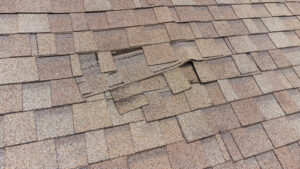
11. Bad Installation
When inexperienced roofers try to cut corners, this leads to a weak roof that can’t handle storms, high winds, and other environmental factors. If you consistently have issues with your roof, notice shingles are missing, experience constant leaks, or think it just looks a little off, have it inspected by a professional.
Spot bad installation by:
- Missing shingles
- Shingles that don’t lie flat
- Leaking
- Dips and high spots in your roof
- Missing flashing
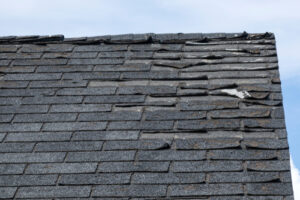
12. Age
When it comes to types of roof damage repairs, no one can escape good, old-fashioned wear and tear. As roofs age, they become more susceptible to the damages listed above. Old roofs can be a safety hazard, so make sure you know when your roof was installed. If it’s nearing the end of its lifespan, it may be time for a replacement.
Spot an aged roof by:
- Warping, cracked, or discolored shingles
- Moss and mildew growth
- Stains in the attic and other signs of moisture
- Sagging ceiling
- Damaged roof valleys
- Rusted nails
Commercial Roof Repairs
Commercial properties experience unique challenges due to their low-slope roofs. Commercial flat roofing has many benefits, but one of its biggest dangers is moisture. Drainage is much more difficult and standing water on flat roofs can easily grow into a problem. If water doesn’t run off the roof correctly, it can cause rotting and leaks.
In addition, many property owners store equipment on their roofs, like HVAC units. Outside vendors may need to handle the equipment, causing damage to your roof in the process. The good news is that flat roofs are much easier to access and inspect when looking for damage.
How to spot commercial roof damage:
- Leaks
- Damaged flashing
- Rust
- Standing water on flat roofs
Know When to Call a Professional
Your roof is vital, and it should be treated with care. If you require one of these types of roof damage repairs, don’t just let the problem sit and hope it goes away. Take a proactive approach and inspect your roof for signs of damage so you know when to call in backup.
Tips For Inspecting Your Roof
- Start on the ground. Walk around your home and examine the exterior for visual signs of damage.
- Head inside. Check for leaks and water stains in your attic. Take note of anything that looks like a problem spot.
- Climb a ladder. If needed, grab a ladder to get a better view of your roof. Check around the gutters and chimney for obvious damage.
- Do not step on the roof yourself. Save that job for us.
If you’re not sure whether something is a serious problem, remember it’s better to be safe than sorry. When you notice damage, are experiencing leaks, need an official inspection, or know your roof is nearing the end of its life, give us a call. A simple repair by a trusted team may solve the problem. If not, we’re here to walk you through an entire roof replacement.
Roofs are important to your home, so a DIY repair won’t cut it. Need an expert opinion? Contact our team at KSW and we’ll scope out your roof before providing you with a free estimate. Once we complete the roofing job, we’ll perform an inspection to make sure everything was installed properly and it will last for years to come.
Importance of Roof Maintenance
The best way to avoid these types of roof damage repairs is by regularly maintaining your roof. When you make inspecting your roof a priority, it can:
- Make your roof last longer
- Save you money
- Maintain your property value
- Prevent serious issues down the line
- Increase the energy efficiency of your home
- Keep you and your family safe
Just like with home maintenance, your roof needs some TLC to continue doing its job well. Here are the essentials for a roof maintenance checklist:
- Check for missing or damaged shingles
- Check for leaks or water stains in your ceiling and attic
- Remove debris from the gutters and roof
- Check for signs of pests
- Inspect flashing
- Wash the roof
- Trim trees
- Examine chimneys, vents, and skylights
- Check fascia and soffits for signs of damage
- Get your roof inspected once a year
Dealing with roof damage? Request a free estimate from our expert team, here to handle anything from a simple repair to a full replacement.

